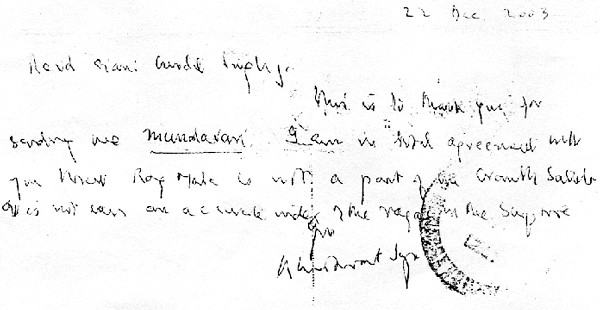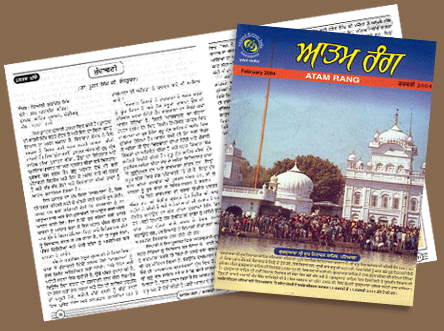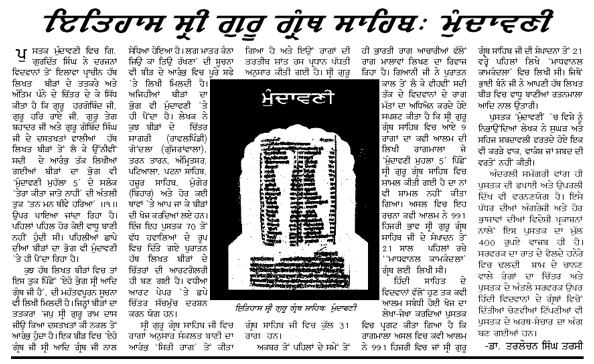
| Revd
Giani Gurdit Singh ji, |
|
This is to thank you for sending
me Mundavani. I am in total agreement
with you that Rag Mala is not a part of the Granth
Sahib. It is not even an accurate index of the
ragas in the scripture.
Yours truly,
Khushwant Singh
New
Delhi
22 December 2003
| Research
Scholar, Writer, Journalist, Editor, Author
– All in One |
 |
Giani Gurdit Singh is a unique
personality. He is a rare combination of a research
scholar, writer, journalist, editor, author –
all in one. He is a man of letters and author
of books on religion, culture and folk lore. He
excelled in every field of activity he touched.
Giani Gurdit Singh is a historian
of a different sort. Like usual historians he
did not write history of events and happenings.
He has written history of the Sikh Scripture;
who wrote it, how was it collected and by whom
and how was it compiled.
He is author of a large number
of books in Punjabi. More popular being Mera Pind
(My Village) Maire Pind Da Jeevan (Life in my
village), Culture of Punjab, Punjab’s Folk
Tales (3 volumes), Festivals, Traditions and Customs,
History of Guru Granth Sahib (Bani of Bhagats),
Bhats and their writings, Takht Damdama Sahib
and Mundawni.
He has also written biographies
of 20 eminent religious and intellectual personalities;
some of the prominent among them being Giani Ditt
Singh, Bhai Sahib Randhir Singh, Akali Kaur Singh,
Bawa Harkishen Singh, Principal Teja Singh, Sardar
Hukam Singh, and Bhai Sahib Ardaman Singh Bagdian.
Giani Gurdit Singh was the publisher
and editor of the daily Parkash newspaper which
he founded in Patiala in 1947. He was only 24
years young at that time. He was also founder,
editor and publisher of Singh Sabha Patrika which
rendered invaluable service to Sikh religion and
Sikh history.
He founded the Kendri Singh
Sabha and worked as its General Secretary and
President. He established two Sri Guru Granth
Sahib Vidya Kendars. He initiated organizing series
of Path Bodh samagams, seminars on religion and
history. He possesses the gift of the gab. He
edited over 100 rare booklets about the tercentenary
of the Khalsa Panth.
Though basically Giani Gurdit
Singh is a writer of religious literature based
on his research, he came in close and intimate
association with some top politicians. He was
one of the closest persons to Giani Zail Singh,
the President of India, (1982-87), Home Minister
(1980-81) and Chief Minister of Punjab, (1972-77).
He was also very close to Sardar Gian Singh Rarewala,
Chief Minister of erstwhile PEPSU (Patiala and
East Punjab States Union) (1948-53) and Sardar
Partap Singh Kairon, Chief Minister of Punjab
(1956-62). Giani Zail Singh and Sardar Rarewala
liked Giani ji mainly because he was doing research
on Guru Granth Sahib, in addition, of course,
to his other qualities of head and heart.
Giani Gurdit Singh is a very
learned person. He, however, earned and self-acquired
knowledge and wisdom the hard way from practical
experience in life and not by attending academic
institutes. God was very kind and generous in
richly compensating him by making a top educationist
as his “better half”, who rose to
become Vice Chancellor of Punjabi University,
Patiala and later elevated as Chairman of the
Staff Selection Commission, Government of India.
One of his two sons obtained Master’s degree
in Journalism from a prestigious university in
America and is well placed in a prominent newspaper
of India.
His latest contribution to Sikh
religious literature is a book titled Mundawni.
He has tried to convincingly and logically prove
with the help of documents that Mundawni written
by Guru Arjan Dev, whose contribution is the maximum
in the compilation and editing of Guru Granth
Sahib, is the last and final hymns enshrined in
Guru Granth Sahib. Raag Maala, printed in Guru
Granth Sahib after Mundawni, he claims, is neither
a divine scripture nor approved and authorized
by Guru Arjun Dev. He has pleaded and proved that
Raag Maala was not included in the Aad (First)
Granth Sahib which Guru Arjun Dev got hand-written
by Bhai Gurdas, and was ceremoniously installed
in the Golden Temple, Amritsar in September 1604.
Though the book “Mundawni”
was published in July 2003, Giani Gurdit Singh
had started doing research and collecting material
for this nearly 60 years back. It is on record
that a meeting between the supporters and opponents
of Raag Maala was held under the chairmanship
of then SGPC President Jathedar Mohan Singh Nagoke
in Amritsar on Dec 10, 1946. Nagoke was also holding
the post of Akal Takht Jathedar at that time.
The opponents of Raag Maala were led by then 23-year
old Giani Gurdit Singh. The leader of the supporters
of Raag Mala was Late Bhai Jodh Singh, then 60-year
old Principal of Khalsa College, Amritsar, who
described Giani Gurdit Singh as a “boy.”
Giani Gurdit Singh presented several photographs
of the last page of different volumes of Guru
Granth Sahib which did not contain Raag Maala
and had concluded with “Mundawni,”
which means end.
Jathedar Mohan Singh Nagoke
was so much impressed by Giani Gurdit Singh with
his brilliant presentation supported by facts,
figures and documentary proof that Raag Maala
was not a part of the original Aad Granth and
was a later fake addition, that he offered to
designate him as “Gurbani Research Scholar”.
But Principal Jodh Singh was so much upset with
the “boy” stealing the show that he
walked out of the meeting.
The ways of almighty God are
strange and unpredictable. That “boy”
became a member of the Punjab legislative Council
(1956-62) at the age of 33 and Principal Jodh
Singh got that honor much later. The wife of that
“boy” succeeded Bhai Jodh Singh as
Vice-Chancellor of Punjabi University, Patiala.
The 81-year
old Giani Gurdit Singh with his so much research
on Guru Granth Sahib has given more to the community
than the community has given to him. Giani ji
richly deserves something more. The community
has not yet repaid its gratefulness to him. As
Bhai Sahib Bhai Randhir Singh told Giani ji on
Oct 24, 1945 in a letter “Satgur will grant
you everything.”
- MOHINDER SINGH
INDIA JOURNAL
Santa Fe Springs, CA USA
FEBRUARY 6, 2004
| Atam Rang Magazine |

|

| Punjabi Tribune |

|

| TOP |
| |
|
MUNDAVNI
Whether the Guru Granth ends with Mundavni,
a composition of Guru Arjan, or with Raagmaala,
which has a disputed authorship, is a matter
that has sporadically engaged the attention
of Sikh scholars for over a century. Mundavni,
literally a legally binding seal should appear
at the end because it indicates the closure
or completion of a seminally important document.
(This is the accepted translation of Mundavni,
though in some dialects of Punjabi the word
also means a conundrum or a brainteaser.)
Then where did the little over one page
of Raagmaala come from?
Most
educated Sikhs would agree that Raagmaala
is an index or listing of the ragas in the
Guru Granth, and it is incomplete at that.
We read it though that it fits neither
the style nor the substance of the Guru
Granth. Yet it has become integral to the Guru
Granth and I reckon it appears in every
printed copy that is available in the marketplace.
Scholars have debated it and rejected
it, yet its persistent appearance continues
to give it life.
So much so that the Sikh Code of
Conduct (Rehat Maryada) takes no
position on this issue. Its recommendation is that Sikhs may chose
to read this composition or not, as they
wish. How did this happen is evidence of the
power of politics or of benign neglect.
Giani
Gurdit Singh is a dedicated scholar
and respected interpreter of Sikh scripture
and related literature. It is appropriate, therefore, that he
has cast an analytical eye on the controversy
that surrounds the Raagmaala- how
it arose and how it continues to be fed
so that it still survives.
In
the early 17th century, when
Guru Arjan compiled the main corpus of the
Guru Granth, a spurious rescension (Bhai
Banno's Birth) appeared and this contained
many additional compositions, including
the Raagmaala and even a recipe for
making ink.
In these early days before printing
when handwritten copies of sacred liturgy
were made by scribes, errors and additions
were not uncommon, either through ignorance,
carelessness or because the spirit so moved
the scribe.
Also Indian culture, rich as it is,
is really one of oral tradition. It has never valued consistency, precision
or accuracy in evidence, whether in history
or literature. The first printed copy of the Guru Granth
debuted in 1864, almost 400 years after
the Guttenberg Bible was printed.
Giani
Gurdit Singh ably explores almost all available
historical rescensions of the Guru Granth
and finds that most did not contain this
spurious composition. Early history is fascinating and provides
some interesting vignettes.
In 1907, controversy broke out in
the Police gurdwara at Kuala
Lumpur (Malaysia)
on whether to read the Raagmaala
or not.
The matter was referred to the Chief
Khalsa Diwan (founded 1901), which ruled
that Raagmaala was not gurbani. A similar decision followed controversy
in Nairobi
gurdwara in 1917. Some gurdwaras resorted to placing two
slips of paper with the choices written
on them in front of the Guru Granth and
picking one at random after prayer.
Raagmaala stood consistently
rejected.
Most
Sikh reformers of that time, including the
Bhassaur group, Chief Khalsa Diwan and Bhai
Veer Singh took a principled stand against
the Raagmaala.
Mcauliffe too concluded that the
Guru Granth concluded with Mundavni,
which was inexplicably followed by Raagmaala-
a composition of a Muslim poet, Alam.
Yet, Bhai Veer Singh, a luminary
of the period, changed his mind in 1917
and started advocating the inclusion of
Raagmaala.
In 1918 Bhai Jodh Singh, another
celebrated Sikh scholar concluded the reading
of the Guru Granth with Mundavni.
In
1920 when Sikhs regained control over the
Akaal Takht, once again they started concluding
the reading of Guru Granth at Mundavni.
This remained true for all the Akhand
paaths that were concluded during the
Gurdwara Reform Movement in the 1920's.
In the first draft of the Rehat
Maryada in 1936, Raagmaala was
rejected.
Yet in 1945, the question was revisited
and finally tabled without its resolution. At this meeting Bhai Jodh Singh had done
an about turn and now supported Raagmaala.
By then Bhai Kahn Singh (Nabha) was
no longer alive, and the debate was dominated
by the sants and mahants of
the time. To be fair, Bhai Jodh Singh was seriously
challenged on his changed stance on this
issue. He answered some and then preferred to
walk out of the meeting. The author of this
book - Giani Gurdit
Singh - was also present at the meeting,
so we have an eyewitness account of history
in the making.
Giani
Gurdit Singh also takes a pleasantly
educational detour and lists several Raagmaalas
composed by poets and musicians of that
era; apparently it was a much-favored style
of versification.
A
whole chapter is devoted to the Muslim poet
Alam who is reputed to have been a contemporary
of Guru Arjan and of Emperor Akbar. With
a plethora of citations from Sikh and non-Sikh
scholars, Giani
Gurdit Singh leaves little doubt that
this Raagmaala, which has become
a part of the Guru Granth, is in fact derived
from an epic poem of Alam celebrating a
love story - a la Romeo and Juliet - that
would be found in every culture.
How it jumped to the pages of Guru
Granth still remains a mystery.
Why do Sikhs keep it there is a bigger
riddle? It appears to me at times somewhat like
the Indian equivalent of the Gordian knot
with its frustrating persistence, which
will only respond to similar treatment.
This
discussion of Mundavni
is an integral part of Giani
Gurdit Singh's fundamental work on Sikh
scripture, "Ithihas
of Guru Granth sahib." The author
has a website, www.gianigurditsingh.com,
where his works are available.
It
is a sad commentary on the popularity of
Sikh literature that this book, which analyzes
such an important matter, is privately published
and not by an important house with worldwide
distribution facilities.
The Sikh Review, Calcutta, April 2004
Book Review
- By I.J. Singh
New York University
|
| TOP |
|